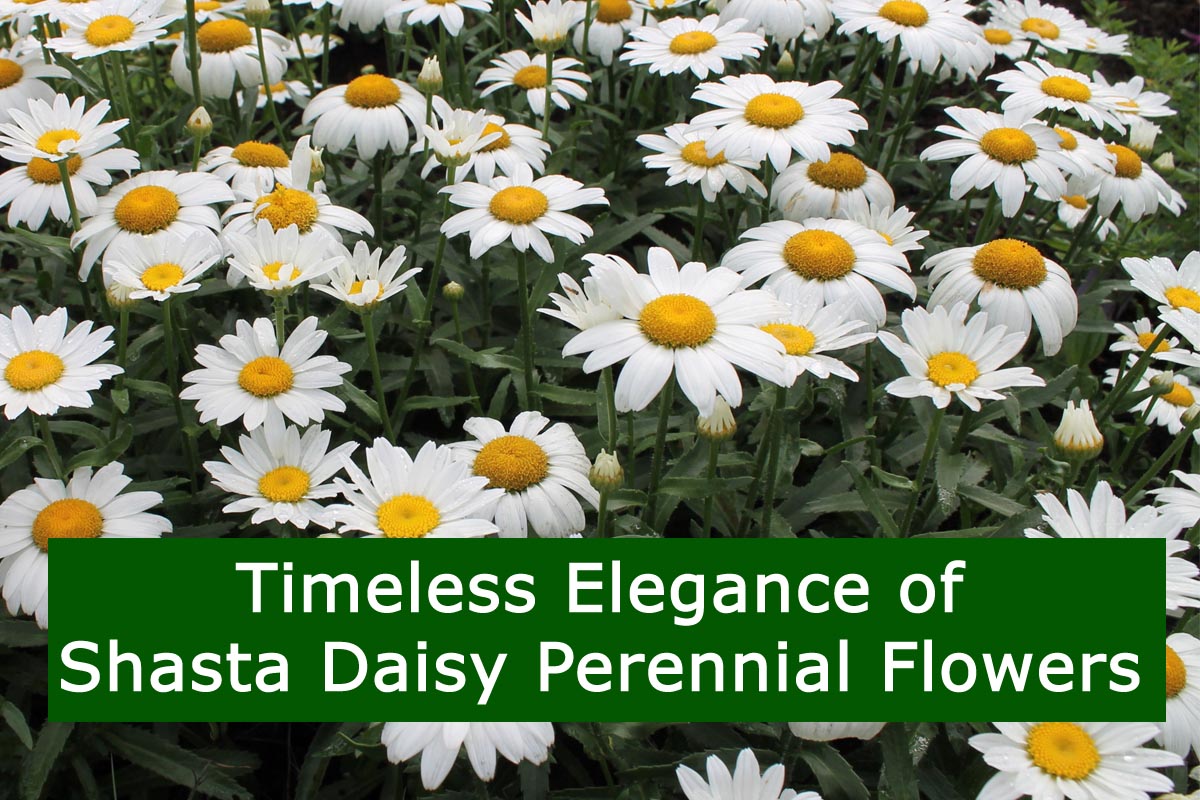
Timeless Elegance of Shasta Daisy Perennial Flowers
In the world of flowers, few embody a timeless elegance quite like the Shasta Daisy. Known for their classic white petals and golden-yellow centres, Shasta Daisies (Leucanthemum x superbum) are perennial beauties that bring an enduring charm to gardens across the globe. we will explore the charm and enduring allure of these beautiful perennial plants.
Timeless Elegance of Shasta Daisy Perennial Flowers
- The Origin of Timeless Beauty
- Distinctive Characteristics
- Versatility in the Garden
- Seasonal Symphony
- Low-Maintenance Grandeur
- Designing with Shasta Daisies
The Origin of Timeless Beauty
The Shasta Daisy, a hybrid created by renowned horticulturist Luther Burbank in the early 20th century, is a crossbreed of several daisy varieties. Named after the snow-capped Mt. Shasta, these flowers boast a purity and simplicity that transcend fleeting trends, making them a staple in gardens for decades.
Also Read This : Cultivating Luck at Home with These 10 Lucky Plants
Distinctive Characteristics
The Shasta Daisy’s allure lies in its simplicity. With pristine white petals radiating from a golden eye, these perennials exude a purity that complements any garden aesthetic. The flowers typically reach a diameter of 2 to 5 inches, standing atop sturdy stems that sway gracefully in the breeze.
Also Read This : Common Shasta Daisy Problems and How to Solve Them
Versatility in the Garden
One of the key reasons behind the Shasta Daisy’s timeless elegance is its versatility in garden design. These perennials seamlessly integrate into various settings, whether planted in formal gardens, wildflower meadows, or cottage-style landscapes. Their ability to thrive in multiple soil types and conditions further enhances their appeal to gardeners of all levels.
Also Read This : Basaman Mama: The Extraordinary Groom Who Sacrificed for a Tree
Seasonal Symphony
Shasta Daisies are not just a one-season wonder. These perennials put on a spectacular show from late spring to early fall, with their blooms standing as a testament to the passing seasons. Their longevity ensures a continuous display of elegance that evolves with the changing backdrop of the garden.
Also Read This : 3 Method to Grow Shasta Daisy: A Beginner’s Guide
Low-Maintenance Grandeur
Adding to their allure is the Shasta Daisy’s low-maintenance nature. Resilient and hardy, these perennials require minimal care once established. Regular deadheading and dividing every few years keep them flourishing, allowing gardeners to enjoy their timeless elegance without overwhelming upkeep.
Also Read This : Devutthana Ekadashi: Worship God with sugarcane, water chestnut and sweet Potato
Designing with Shasta Daisies
Whether used as focal points, border plants, or as part of a larger landscape scheme, Shasta Daisies bring a touch of timeless elegance to any garden design. Their white blooms act as a canvas, harmonizing with various companion plants and allowing for creative landscaping expressions.
Also Read This : Blooms in the Chill: Flowers to Plant in Texas Fall and Winter, USA?
Shasta Daisies Care
These perennial wonders are stunning and remarkably resilient, making them an excellent choice for novice and experienced gardeners. This comprehensive care guide will walk you through the essential steps to cultivate and maintain these classic blooms to ensure your Shasta Daisies thrive and continue to grace your garden with their elegance.
Choosing the Right Location
- Shasta Daisies thrive in full sunlight. Choose a location that receives at least six hours of direct sunlight daily.
- Ensure the soil is well-draining, as these plants do not tolerate waterlogged conditions.
Planting Shasta Daisies
- Plant Shasta Daisies in the spring or fall.
- Dig a hole twice the diameter of the root ball and place the plant at the same depth it was in its container.
- Space plants about 18 to 24 inches apart to allow for proper air circulation.
Also Read This : Top 10 Proven Methods for Radish Cultivation
Watering
- Water deeply but infrequently to encourage profound root growth.
- Once established, Shasta Daisies are somewhat drought-tolerant, but regular watering during dry spells will promote healthier plants and more prolific blooms.
Soil Enrichment
- Shasta Daisies prefer fertile soil. Amend the soil with organic matter, such as compost, before planting.
- A slightly acidic to neutral soil pH between 6.0 and 7.0 is ideal for these perennials.
Also Read This : From Seed to Harvest: Growing Onions Simplified
Fertilizing
- Fertilize in early spring with a balanced, all-purpose fertilizer.
- Avoid excessive fertilization, as Shasta Daisies generally don’t require heavy feeding.
Deadheading
- Deadhead spent flowers regularly to encourage continuous blooming.
- Cut the flower stems back to the basal foliage to promote a tidy appearance and prevent self-seeding.
Pruning
- Cut back the foliage in late fall or early spring to promote a flush of new growth.
- This helps maintain a more compact shape and encourages vigorous flowering.
Also Read This : Turn Your Home Into A Paradise With These Ornamental Plants
Pests and Diseases
- Keep an eye out for aphids, mites, and leaf spot diseases.
- Address pest and disease issues promptly using organic remedies or insecticidal soap.
Division
- Divide mature clumps every 2-3 years to rejuvenate the plants and prevent overcrowding.
- The division is best done in early spring or fall.
Winter Care
- Shasta Daisies are generally hardy, but a layer of mulch around the base in late fall helps insulate the roots.
- In colder climates, consider covering plants with burlap for added protection.
Also Read This : When and How: The Ultimate Succulent Repotting Guide
As trends in gardening come and go, the Shasta Daisy stands as a perennial testament to timeless elegance. From their historic origins to their versatility in garden design, these flowers have transcended generations, captivating the hearts of garden enthusiasts worldwide. Embrace the enduring beauty of Shasta Daisies and cultivate a garden that stands the test of time with these classic perennials.




